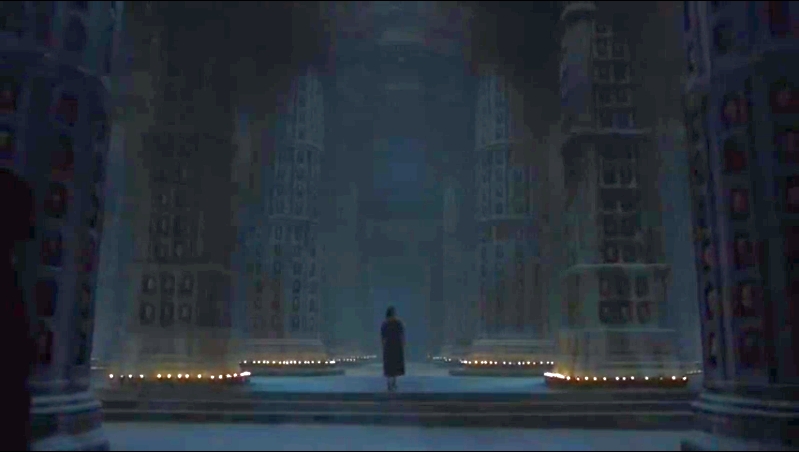
Arya Stark in the Temple of the Faceless Men, Game of Thrones (S05E06).
George R. R. Martin's epic fantasy series, A Song of Ice and Fire, has won wide acclaim, both in book format and in its TV adaptation Game of Thrones
(also the title of the first volume). Notable for its brutality,
violence, and sexual misconduct, the series can perhaps best be
described as a fantastic history of medieval Europe. As one critic
remarked about the episode to be discussed (S05E06), it constitutes an
“attack on family, values, and family values.”It is surprising, then, that it should contain anything related to Sufism. And yet it does. This is still another indication of what I have been arguing for a while: the spontaneous emergence of Sufic contents in the culture of our times.
Martin seems to have modeled the Faceless Men on Hasan Sabbah’s Order of the Hashishins (“Assassins”), notorious historically for their murder of the Seljuki grand vizier, Nizamul Mulk (allegedly a childhood friend of Sabbah’s), among other worthies. The Faceless Men believe in the One God of Many Faces, and they present their “gift”—of death—for a high price.
So far, there is little to suggest any connection with Sufism. Only if death is understood in a figurative sense, as the death of the ego and “extinction in God” (fana fi-Allah), can any link with Sufism even be considered. But bear with me a moment longer.
For the first time, Arya Stark is admitted into the locked chamber of the temple where she has taken refuge, which is ordinarily off limits. There, in niches on pillars, she sees thousands of faces of Faceless Men who have gone before and left their faces behind. These pillars could be considered to symbolize Sufi Chains of Transmission (silsila). Then her mentor intones:
Is the girl ready? To give up her ears, her nose, her tongue, her hopes and dreams, her loves and hates, all that makes a girl who she is… forever? No, that girl is not ready to become no one...
 What
her mentor is describing is to be shorn of human attributes. It is only
after one is stripped of all these that a person can be invested with
Divine attributes. So, no, Arya is not ready to “become No One.” This is
the first point in consonance with Sufism.
What
her mentor is describing is to be shorn of human attributes. It is only
after one is stripped of all these that a person can be invested with
Divine attributes. So, no, Arya is not ready to “become No One.” This is
the first point in consonance with Sufism.Next, her mentor continues:
... but she is ready to become someone else.In Sufism, this would refer to a precursor of “extinction in God,” which is “extinction in the Master” (fana fi-shaykh) or, more primarily, “extinction in the Master’s morality.” For only if one attains a higher moral stature like one’s master is spiritual progress possible. As I have written elsewhere:
By imitating the Perfect Human, those who follow him have the possibility to become what they pretend to be. By emulating such a praiseworthy personality, each follower affirms that personality within himself. In time, one’s whole being begins to fill in those ideal outlines. One grows into that mold, until one is reborn in the image of the new personality. One must let the master who is in one come out.The new personality has a new akhlaq, which means both “character traits” and “morals.” Once one has become a different person ethically, or grows into those contours, one is ready to take the next step, to go on to something else. This is very similar spiritually to the metamorphosis of a caterpillar into a butterfly.
(The Black Pearl (2005), p. 21/57.)
No matter where Martin’s storyline may lead in the future, then, he has touched on a couple of Sufic points, if only tangentially.

